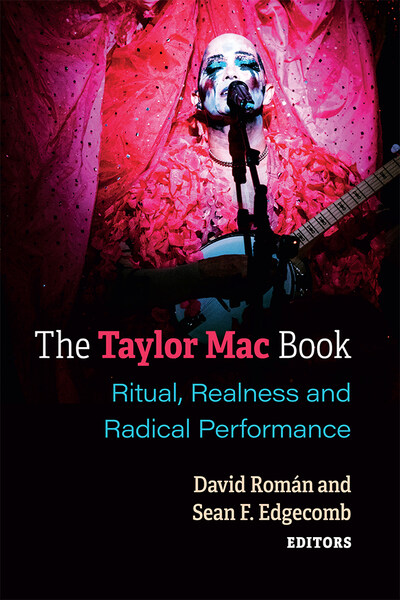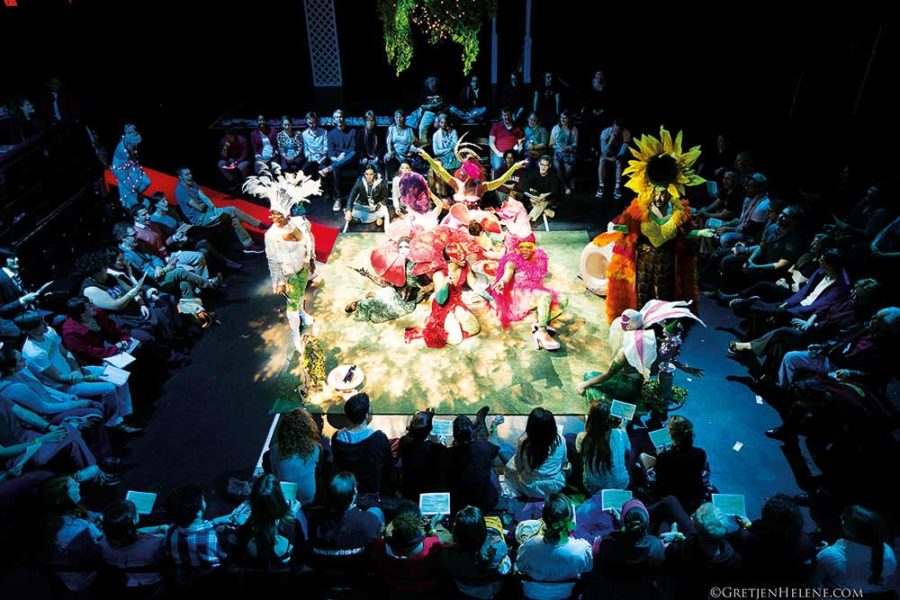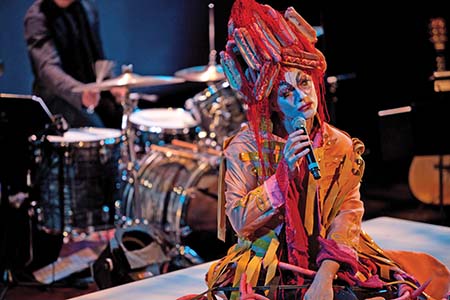The following is an edited excerpt from The Taylor Mac Book: Ritual, Realness and Radical Performance, an anthology of essays about judy’s work and its significance, to be published in February by University of Michigan Press.
On receiving the Edwin Booth Award at the City University of New York’s Graduate Center on April 28, 2017, Taylor Mac chose neither to give a speech nor to sing a tune, but rather to read aloud Walt Whitman’s poem “Crossing Brooklyn Ferry.” Several minutes into the recitation, he interjected, “Don’t worry, just 25 more pages! Because Walt Whitman, like me, likes to make something go on a little bit longer than it should.” Delivered with sorry-not-sorry aplomb, it was a line guaranteed to charm the audience—and perhaps also to recapture the attention of minds wandering away from a 26-stanza poem written in the mid-19th century. But it also calls attention to what I argue is Whitman’s aesthetic and political place in A 24-Decade History of Popular Music: at its center.
That Whitman is one of the History’s heroes is obvious to anyone who has heard and seen Mac recite portions of Leaves of Grass during performances of the 1846–56 segment. In “Whitman vs. Foster: Songs Popular Near the Breaking Point,” Mac champions the poet as the true “Father of American Song” in the first moments of what is supposed to be a knock-down, drag-out battle for that title. Whitman’s opponent in this unabashedly rigged contest is Stephen Collins Foster (1826–64), the composer and lyricist who is usually granted the accolade. Staged during the 24-hour St. Ann’s Warehouse performance (Oct. 8-9, 2016) as a mock wrestling match conducted in and around a red, white, and blue-roped ring, “Whitman vs. Foster” argues that the aesthetically innovative and politically progressive Leaves of Grass is the “song” we should have heard America singing since its initial publication in 1855. Historically, of course, what much of America was actually singing during that decade—and long after—were Foster’s indelible tunes. A wide readership was still out of Whitman’s reach; his eventual canonization as America’s “Good Gray Poet” would have seemed impossible, perhaps even to him, during the period encompassed by the History segment.

I want to make clear the main points, as well as the stakes, of my argument about the show’s uptake of Whitman’s poem and his initial persona. Whitman’s vision of America—aptly described by Thomas Yingling as a “homosexual utopia”—and his poetic practice of superabundance permeate the History. Like Whitman, Mac not only “hear[s] America singing,” but also is singing a specifically queer America into being. It is a capacious, various, and perpetually emergent utopia—a poetic entity that gives its people an extended duration in which they can feel what the nation has been, is now, and might become if we all “get up and play” with and for one another. I call up Yingling’s circa-1992 essay here because he was one of the first publicly out American scholars to recognize that the forms of same-sex attachment articulated in Leaves are integral to its politics. Before he could complete that essay Yingling died of AIDS, like the many thousands of gay people whose relentless activism in the face of widespread illness and murderous government indifference inspired not only the History, but also the commitment to queer community-building evident in all Mac’s work. Yingling helped seed a thriving field of Whitman scholarship that has shaped Mac’s understanding of the poem and his performance of its politics, whether or not we believe judy’s jokey disavowals of academic standards. (Calling the audience’s attention to the history-inspired details of designer Machine Dazzle’s intricate costumes, Mac asked, “What about this says more than Wikipedia?”) I draw on that Whitman scholarship, sparingly but pointedly, to show how and why Mac’s very contemporary American History elevates the 19th-century bard of democratic bonding.
In Whitman’s American utopia, and in Mac’s, what binds the nation is not the state, much less its elected officials. (So skeptical is Mac of all leaders that the History disperses his own authority in its first minutes, when judy bids the audience to “worship the act of creation, not the creator.”) It is not the land that lies between its perpetually contested borders. It is not even a shared culture. It is love—a very particular type of love that Whitman called “adhesive,” using a term of his era. This is not the love of the heterosexual reproductive pair privileged by church, state, and nearly all mass cultural products. Adhesive love is erotic, but not necessarily genital; it is of the body, yet it transcends the flesh. It is intimate, but not personal; indeed, adhesive lovers can be strangers. Though some “comrades” are closer than others, the union they build is nonexclusive and nonproprietary. “In Whitman’s homoerotic vistas,” Betsy Erkkila explains, “the love of strangers models the public culture of male love that he imagines as the future of democracy: the stranger exists as an unknown figure, a foreigner in public space, outside the prescribed intimacies of home, marriage, and family.” Both Whitman and Mac present queer, public sexual expression as the ground on which they and their audiences are creating an American utopia that remains always on the horizon. Whitman’s poem privileges cruising in New York City’s streets, while Mac’s performance exalts anonymous sex in its nightclubs. Both artists offer up their exceedingly open, adhesive, absorptive, multiplicitous, temporally transcendent bodies and works as exemplars of queer, utopian, democratic world-making. Hearing that reading of “Crossing Brooklyn Ferry,” I could not help but think about how Mac’s choice of text, like the selection of that particular waterfront location for the New York City History performances, ties into what Jose Esteban Muñoz identified as an exceptionally “dense connective site in the North American queer imagination”—a cruising ground, in many senses. For both Whitman and Mac, the waterfront pulses with what Muñoz so influentially described as “the possibility of queer transport, leaving the here and now for a then and there” that enfolds the turbulent past while enabling a freer future. It is the possibility of that future to which the 19th-century poet and the 21st-century performer dedicate themselves, their audiences, and their maximalist works.
‘Longer Than It Should’: Superabundance and Queer Aesthetics
Having discussed how Mac and his audiences are cruising an American utopia, I now return to his assertion that the History, like Whitman’s poem, must go on “a bit longer than it should.” Among the many arguments that scholars and artists have made about durational performance is that its relatively extreme length disrupts the late-capitalist—which is also to say heterosexist—temporal regime that Elizabeth Freeman calls “chrononormativity.” For Mac, a major benefit of durational performance is that its jarring length dislodges audience members from their regular, work-oriented schedules and releases them into an altered state in which they can become “deranged in their emotional availability.” He believes that this distinctly queer temporality makes it possible for all audience members to “transform”—or, at the very least, to glimpse alternatives to the distressing day-to-day and historical timelines in which they live.
While the History is Mac’s longest produced work to date, it is not the only one that can be described as durational. Near the top of The Lily’s Revenge (2009), a character informs the audience that “This play is LOOOOOOOONG”—and it is, by anyone else’s standards. Over nearly five hours, across five acts, a cast of 40 performs an allegorical and boisterously theatrical destruction of modern Western dramatic structures that contain social problems—often resolved with a wedding—within an easily digestible two-hour time frame. “Culinary theatre” is the dismissive term given to these dramatic forms by Bertolt Brecht, whose Good Person of Szechwan Mac performed to such piquant and poignant effect in 2013 with the Foundry Theatre. However, in the absence of other aesthetic qualities, temporal indigestibility does not a queer performance make. Forced Entertainment also does 24-hour shows; they, too, are messy, metatheatrical, and marvelous. But they are not queer. The Lily’s Revenge and the History are queer durational performances because Mac and company complement those extended running times with other forms of aesthetic extremity, including a distinctive style that Jason Fitzgerald describes as “camp extravaganza” inflected by an “adorable, comic self-deprecation,” a keen intelligence, and a deep ethical commitment to community-building. Sean F. Edgecomb persuasively links this style to Charles Ludlam’s Ridiculous Theatre, with its blatant theatricality, its formal multiplicity, and its outsized intellectual and political ambition. In Ludlam’s plays and in Mac’s durational work, genderfuck meets genrefuck; excess—hyperbole, even—is crucial to the art and essential to its politics.

Too-muchness of too many kinds is what makes Mac’s durational art queer. Too-muchness is also a prime Whitmanian trait, as Mac acknowledged explicitly at CUNY and implicitly during History performances. Among Whitman’s many formal innovations is the famous “long line,” that primary unit of his free verse that is so very capacious and so fully flexible that it sometimes feels like disquisitory prose. (Indeed, in the 1855 edition, much of the poetry looks very much like prose, too.) Not only are the lines long; the poems within Leaves can themselves feel endless, especially when Whitman goes into catalog mode. As metapoetical as Mac is metatheatrical, Whitman writes that he “Know[s] my omnivorous lines and cannot write any less.” Mac delivers those omnivorous lines with vocal virtuosity, but even he has to push so far toward the end of his breath while reciting them that the audience whistles and applauds in appreciation of what they recognize as a feat of mental and physical endurance. Moreover, Mac’s selection shows a preference for Whitman’s longest poems, including “Song of Myself,” “Song of the Open Road,” and “Crossing Brooklyn Ferry.” It is these poems that James Perrin Warren cites when he writes that “the long line captures the expansive freedom of Whitman’s poetic style and evokes his vision of an expansive American culture,” adding that “it is nonetheless an orderly poetic practice.” Both Leaves and the History are as capacious as they are because they must make room for disorder as well as order, for disintegration and integration, for gathering and dispersal—in Mac’s words, for “falling apart” as well as “building up.” The artists build imperfection and failure into their respective projects, arguing strenuously that it is because they depart from normative aesthetics that they can do real democratic work.
Mac’s refrain, “Perfection is for assholes,” is a quip worthy of another queer apostle of aesthetic excess, Oscar Wilde, however far its sentiment departs from Wilde’s own penchant for polished surfaces. Imperfection affords an accessibility that both Mac and Whitman link to the popular. Explaining the choices he made when compiling the History’s set list, Mac said that “classical song is about reaching for perfection—touching the hem of God. Popular song is about reaching the people, and it uses its imperfection in order to do that.” Mac, like Whitman’s “American bard,” knows that “the pleasure of poems is not in them that take the handsomest measure and similes and sound,” and the people’s pleasure cannot be sacrificed if the art is to do its work. That work is nothing less than making a fully democratic world, the form of which is as unfixed as the East River, whose unceasing ebb and flow Whitman and Mac present as a vision of a queer utopian aesthetics that encompasses the poem, the poet, and the people: “The simple, compact, well-joined scheme—myself / disintegrated, every one disintegrated, yet part / of the scheme.”
The Archival ‘Body Electric’
You, too, are part of the scheme. Yes, you, reader, whoever and whenever you are. Whitman’s poem insists that he is cruising you right now as you read his lines, and was cruising all of us gathered on the East River’s bank in October 2016, who caught glimpses of the “flood-tide” and “ebb tide,” on which he’d built so much of his poetry and democratic theory, as we took breathers or smoke breaks or made calls or looked across at the bridge or the skyline or up at the stars or the dawn or the rain or all of the above during the St. Ann’s Warehouse shows.
I am with you, you men and women of a generation,
or ever so many generations hence;
I project myself—also I return—I am with you, and know how it is.
The medium that ensured Whitman’s access to you is the book, which he knew how to design, compose, print, bind, and advertise. His poems are replete with language that creates a complex erotic bond between writer and reader that extends across time and space because books do. The poet might not know your name—indeed it’s more properly adhesive if he doesn’t know—but he knows that when you read his lines you will be “holding me now in hand.” It gets sexier from there on. It’s not only Whitman’s body that is the “electric” conduit for the charges of affection that will adhere the nation; it’s also the book, as an object, which he believes will carry those pulses across time and space and into an American future inhabited by the American lovers whom his all-encompassing vision already embraces. Mediation is no barrier to this form of stranger-intimacy.

In Mac’s work, too, written and printed objects transmit not just knowledge but also affect, across bodies and across time. Bundles and suspended streams of typed and handwritten written letters are central to Mac’s solo autobiographical play The Young Ladies Of… (2005), which takes its title from a 1968 call for correspondence that his late father sent out while stationed abroad with the U.S. military. In one of the play’s most poignant images, Mac’s performance as “archival inquirer” takes on the form of a dance with the letters, which are animated by Basil Twist’s puppetry before settling into the shape of a wearable dress. If anything, bodies, archival documents, and objects are even more firmly and pleasurably entangled in the History. Many of the songs, most of the costumes, and more than one menu were reconstructed from research the creative team conducted using archival documents, some of which (like Miss Beecher’s Domestic Receipt Book, 1871) they take pains to cite directly.
And then there are the mannequins. In a review of the 24-hour show, Kalle Westerling described the “living costume installation” in the St. Ann’s Warehouse lobby, which designer Machine Dazzle created over the course of the show by dressing 24 mannequins with the costumes that Mac removed at the end of each hour. (The installation subsequently toured to other venues.) Westerling, who emphasizes the ritual aspects of the performance, rightly calls this installation a “reliquary,” stressing the transformational potential of the objects in the installation and those that spectators took away from the theatre. These objects, he argues, “continue to move the performance’s time and space into our everyday lives… Who is to say that the transformation is not still going on?”
It is: I know it, I feel it (the ping-pong ball that made its way from the St. Ann’s Warehouse floor to my pocket to an airplane to my desk tells me so), it hasn’t ended, the American utopia we glimpsed in that ecstatic time is possible, in spite of everything, I can never un-see what we saw, we’ll never arrive but we have to keep going, having felt what we felt we are just as Mac said we were, saying Whitman’s words: “We are insatiate henceforward.”
Jennifer Buckley is associate professor of English and theatre arts at the University of Iowa, where she teaches courses in modern and contemporary drama and performance.





